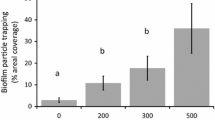Abstract
The hypothesis that drifting red algal mats inhibit settlement of planktonic larvae was tested in a field experiment in 1986. Substratum free of algae (caged boxes) was compared with substratum covered with algae (natural substratum and open boxes). Whereas settling densities of 1500 to 5500 ind. m-2 of the bivalves Macoma balthica, Cardium glaucum and Mya arenaria were observed in sediment without algal cover, no recruits of the same species were found beneath the algae during the period of peak settlement (June to July). The same difference was observed for the polychaete Nereis diversicolor, although in this case occasional individuals were found beneath the algae. The results demonstrate that algae mats may be efficient inhibitors of larval settlement to benthic soft-substratum communities. It is concluded that algae act as a larval filter.
Similar content being viewed by others
Literature cited
Andrews, J. (1979). Pelecypoda: Osteridae. In: Giese, A. C., Pearse, J. S. (eds.) Reproduction of marine invertebrate. Volume V. Molluscs: pelecypods and lesser classes. Academic Press, New York, p. 293–341
Boesch, D. F., Wass, M. L., Virnstein, R. W. (1976). The dynamics of estuarine benthic communities. In: Wiley, M. (ed.) Estuarine processes. Academic Press, New York, p. 177–196
Dales, R. P. (1950). The reproduction and larval development of Neries diversicolor O. F. Muller. J. mar. biol. Ass. U.K. 29: 321–360
Eckman, J. E. (1979). Small-scale patterns and processes in a softsubstratum, intertidal community. J. Mar. Res. 37: 437–457
Eckman, J. E. (1983). Hydrodynamic processes affecting benthic recruitment. Limnol. Oceanogr. 28: 241–257
Elliott, J. M. (1977). Some methods for the statistical analysis of samples of benthic invertebrates. Freshwater Biological Association, Windermere
Gaines, G., Roughgarden, J. (1985). Larval settlement rate: A leading determinant of structure in an ecological community of the marine intertidal zone. Proc. natl. Acad. Sci. U.S.A. 82: 3707–3711
Gray, J. S. (1974). Animal-sediment relationships. Oceanogr. mar. Biol. A. Rev. 12: 223–261
Grosberg, P. K. (1981). Competitive ability influences habitat choice in marine invertebrates. Nature, Lond. 290: 700–702
Hannan, C. A. (1981). Polychaete larval settlement: Correspondence of patterns in suspended jar collectors and in the adjacent natural habitat in Monterey Bay, California. Limnol. Oceanogr. 26: 159–171
Hannan, C. A. (1984). Planktonic larvae may act like passive particles in turbulent near-bottom flows. Limnol. Oceanogr. 29: 1108–1116
Hartman, J., Caswell, H., Valiela, I. (1983). Effects of wrack accumulation on salt marsh vegetation. In: Cabioch, L., Glemarec, M., Samain, J.-F. (eds.) Proc. 17th Eur. Mar. Biol. Symp. Oceanol. Acta, Paris, p. 99–102
Jumars, P. A., Nowell, A. R. M. (1984). Fluid and sediment dynamic effects on marine benthic community structure. Am. Zool. 24: 45–55
Levin, L. A. (1983). Drift tube studies of bay-ocean water exchange and implications for larval dispersal. Estuaries 6: 64–371
Levin, L. A. (1984). Life history and dispersal patterns in a dense infaunal polychaete assemblage: commnity structure and response to disturbance. Ecology 65: 1185–1200
Meadows, P. S., Campbell, J.I. (1972). Habitat selection by aquatic invertebrates. Adv. Mar. Biol. 10: 271–382
Ólafsson, E. B. (1986). Density dependence in suspension-feeding and deposit-feeding population of the bivalve Macoma balthica: A field experiment. J. Anim. Ecol. 55: 517–526
Pechenik, J. A. (1984). The relationship between temperature, growth rate, and duration of planktonic life for larvae of the gastropod Crepidula fornicate (L.). J. exp. mar. Biol. Ecol. 74: 241–257
Peterson, C. H. (1982). The importance of predation and intra-and interspecific competition in the population biology of two infaunal suspension-feeding bivalves, Protothaca staminea and Chione undatella. Ecol. Monogr. 52: 437–475
Rosenberg, R. (1976). Benthic faunal dynamics during succession following pollution abatement in a Swedish estuary. Oikos 27: 414–427
Roughgarden, J., Iwasa, Y., Baxter, C. (1985). Demographic theory for an open marine population with space-limited recruitment. Ecology 66: 54–67
Scheltema, R. S. (1974). Biological interactions determining larval settlement of marine inevertebrates. Thalassia Jugosl. 10: 263–296
Simon, J. L., Dauer, D. M. (1977). Reestablishment of a benthic community following natural defaunation. In: Coull, B. C. (ed.) Ecology of marine benthos. Univ. South Carol. Press, p. 139–154
Thrush, S. F. (1986). The sublittoral macrobenthic community structure of an Irish sea-lough: effect of decomposing accumulations of seaweed. J. exp. mar. Biol. Ecol. 96: 199–212
Underwood, A. J., Denley, E. J., Moran, M. J. (1983). Experimental analyses of the structure and dynamics of mid-shore rocky intertidal community in New South Wales. Oecologia (Berl.) 56: 202–219
Williams Cowper, S. (1978). The drift algae community of seagrass beds in Redfish Bay, Texas. Contrib. mar. Sci. 21: 125–132
Wilson, W. H. Jr. (1983). The role of density dependence in a marine infaunal community. Ecology 64: 295–306
Woodin, S. A. (1974). Polychaete abundance patterns in a marine softsediment environment: the importance of biological interactions. Ecol. Monogr. 44: 171–187
Woodin, S. A. (1976). Adult-larval interactions in dense infaunal assemblages: Patterns of abundance. J. mar. Res. 34: 25–41
Woodin, S. A. (1985). Effects of defecation by arenicolid polychaete adults on spionid polychaete juveniles in field experiments: selective settlement or differential mortality. J. exp. mar. Biol. Ecol. 87: 119–132
Author information
Authors and Affiliations
Additional information
Communicated by T. Fenchel, Helsingør
Rights and permissions
About this article
Cite this article
Ólafsson, E.B. Inhibition of larval settlement to a soft bottom benthic community by drifting algal mats: An experimental test. Marine Biology 97, 571–574 (1988). https://doi.org/10.1007/BF00391053
Accepted:
Issue Date:
DOI: https://doi.org/10.1007/BF00391053




